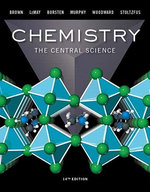Chemistry
Chemistry: The Central Science 14th Edition solutions
Author: Theodore E. Brown; H. Eugene LeMay; Bruce E. Bursten; Catherine Murphy; Patrick Woodward; Matthew E. Stoltzfus
Publisher: Pearson
ISBN: 9780134414232
Buy the book
Select Chapter:
